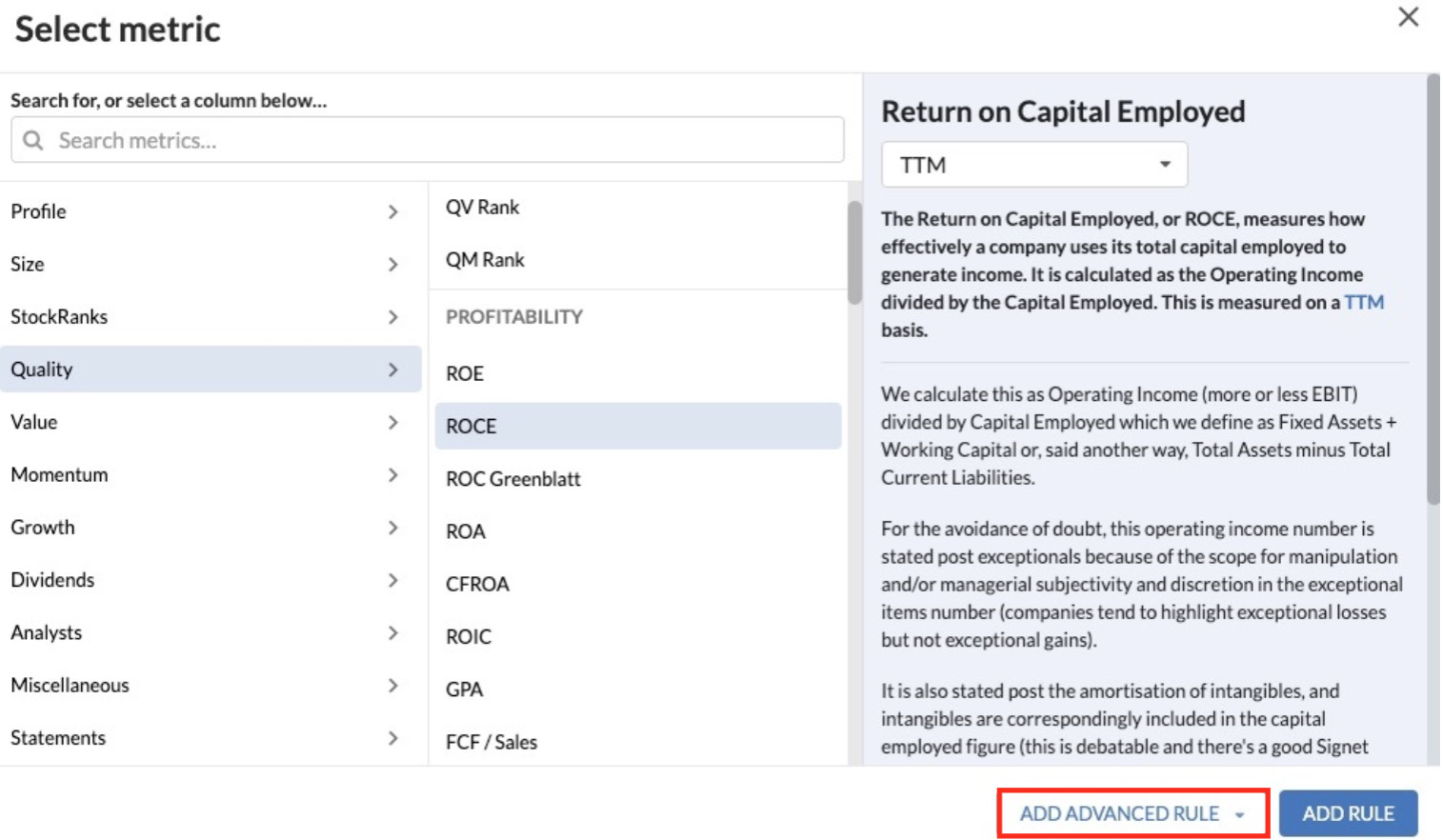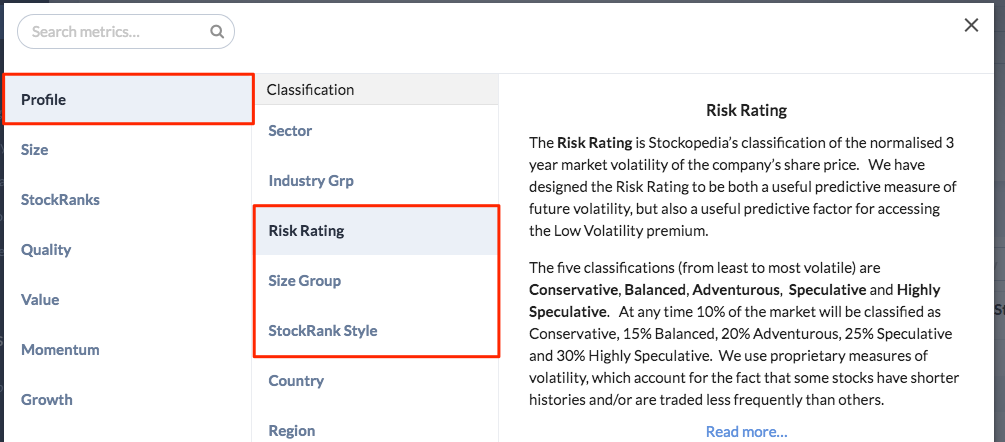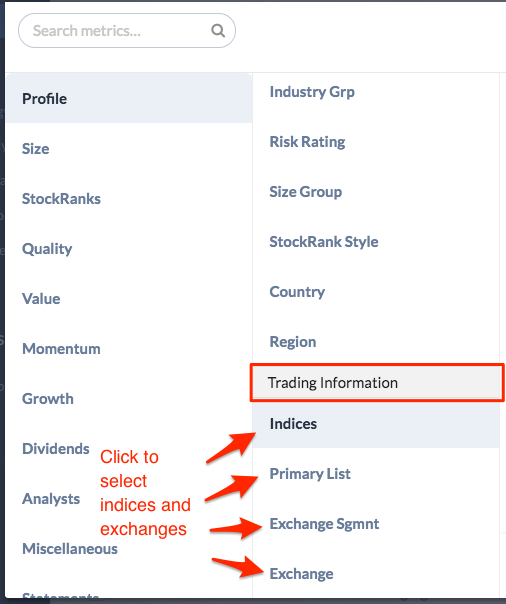Building advanced screening rules
Basic stock screening, which we introduced in the previous guide article, is a quick and easy way to filter down the thousands of stocks in the market to a manageable number.
But Stockopedia Screens also offer a much higher level of finesse and customisation. In this short article you’ll learn all about our variety of advanced screening rules.
Rule Types
Simple Rules
* Simple ratio rules
* Ratio vs Ratio rules
Aggregates Rules
* Ratio Averages
* Ratio Rankings
Classification Rules
* Sectors & Industries
* Risk / Size / Style
* Country & Region
Trading Information
* Indices
* Primary Listings
* Exchange Segments
* Exchanges
Advanced screening rules: Getting started
To get started, click the blue Add Rule button from you screen to launch the Ratio Picker.
By default the Ratio Picker will help you construct simple screening rules. But once you've selected the ratio you want to use from the left side of the Ratio Picker, you'll also have the option of using an advanced rule with the Add Advanced Rule button.
Note! Advanced rule options aren't relevant to some of the metrics in the Ratio Picker - so you'll only see the Add Advanced Rule button if it's available.

Different rule types
Firstly we’ll look at some simple rules.
Basic Rules
The most basic rule type simply allows you to choose a ratio or metric and compare it with a value (For an explanation, see "Adding your first rule" in Building a Custom Screen).
Compare Rules
On the Add Advanced Rule menu, Compare rules - or Ratio vs. Ratio rules - allow you to compare a ratio versus a multiple of another ratio. You can be as creative as you want here… but as an example we can try to search for reasonably priced growth stocks… where the P/E ratio is less than half of the EPS Growth rate.
Median Rules and Average Rules
On the Add Advanced Rule menu, you'll find Average Rule and Median Rule options. These rules allow you to find stocks whose metrics rate either above or below the Market, Sector or Industry averages.
We deliberately offer mean and median average options in the screener. It is worth understanding that mean ratios can be highly skewed for financial data due to the presence of outliers.
We do winsorize distributions at the 3% level when calculating means, but they can still be skewed. We prefer to use medians in-house as they are more appropriate for many of the mid cap and small cap stocks that many private investors prefer to hunt in.
Once you've selected your ratio in the Ratio Picker and opted for either the Average Rule or Median Rule, click Add Rule and your rule will appear on your screen. From there you can use the drop-down menus to refine it further:

Ranking Rules
This rule allows you to search for stocks with the best or worst ranking for any ratio against all the stocks in your subscription universe.
This allows you to select a metric or ratio and compare how it ranks against its sector or industry or the market as a whole.
We standardise these ranking metrics as percentiles from 0 (worst) to 100 (best). So 100 can be thought of as fastest growth, cheapest valuation, highest profitability etc with zero as the opposite.
You can look for stocks with a percentage ranking position that’s ‘Equal to’, ‘Greater than’ or ‘Less than’ whatever value you choose.
You can refine Ratio Rankings even further by creating complimentary rules. For instance, when searching for high, but not excessive dividend yields, you might look for companies with yields that are ‘Greater than’ 80% of the market but ‘Less than’ 90%. That would give you a 10% band towards the top of the market to investigate further.

Other types of rules
In addition to Basic and Advanced screening rules, the Ratio Picker also has a range of other rules that can help you screen the market:
Classification Rules
Classification rules allow you to narrow your search by using the classification of a stock either against a sector or industry, index like the FTSE 100 or S&P 500 or by stock exchanges on which it may or may not listed.
Sectors & Industries
There are 10 economic sectors and 54 industry groups available on Stockopedia - so choosing whether to screen by sector or industry is the first decision. Let’s filter by sector.
You can use the Ratio Picker to focus your screening rules on specific Sectors or Industry Groups.
Click Add Rule to launch the Ratio Picker, and then select Profile and choose between Sector or Industry Grp. Click Add Rule at the bottom of the Ratio Picker to return to your screen.

Once you've added the rule to your screen, you can refine it by using the drop-down menus to either include or exclude Sectors or Industry Groups from your results.

The Sectors & Industry Groups rules allow you to further narrow the selection of stocks by their business type. You can read more about our hierarchical sector and industry classification in the Technical Guide.
Risk Rating, Size Group and StockRank Style
The Risk Rating, Size Group and StockRank Style rules in the Ratio Picker allow easy screening using our triad of proprietary classification filters.
From the Profile section of the Ratio Picker, select the rule you want (and then click Add Rule to return to your screen).

Next, you can adjust your rule to include or exclude classifications from a menu of options for each of the Risk, Size and Style categories.

Whether you are looking for Speculative Small Cap Value Traps, or Conservative Large Cap High Flyers, these filters make searching the market a breeze.
Country and Region
The final classification rules cover the country or geographic regions.
- Use the Country rule to define the country (eg. UK or US) that a stock trades in. For example, if a stock trades on the London Stock Exchange, then the stock's country would be the UK.
- Use the Region rule to control the geographic scope of your screen and define which region (eg. Europe) that a stock trades in. For example, if a stock trades on the London Stock Exchange or the Oslo Stock Exchange, then the stock's region would be Europe.
Trading Information
To focus your screen on specific Indices, Primary List stocks, Exchange Segments or Exchanges, you can select these options under Trading Information in the Ratio Picker.

Indices
Selecting Indices from the Ratio Picker will give you a rule with which you can select a specific index (or indices) to include or exclude.
In the UK there are a range of indices to choose from, including the FTSE 100, FTSE 250, FTSE SmallCap and the Alternative Investment Market (AIM), among others. We also cover a very broad range of international benchmarks, including the S&P 500 and the FTSEurofirst 300.
Including and excluding dual-listed stocks
Generally, dual-listed stocks create a fair amount of ‘noise’ in screening results. These are stocks which trade on the local stock market but whose primary listing is abroad.
Many investors choose to exclude dual listed stocks from searches because liquidity can be poor. But some very large and famous stocks can be dual listed (like Royal Dutch Shell) so you may wish to include them.
You can quickly change the dual list setting for a screen by ticking or unticking the dual lists checkbox. The screen results will adjust automatically.

For more precision, the Ratio Picker includes a rule for including or excluding Primary Listed stocks. Select Primary List from the menu and then adjust the rule as follows.
- Set the Primary Listing value as 'equal to' 1 to include only primary listed stocks in your results.
- Set the Primary Listing value as 'equal to' 0 to exclude primary listed stocks from your results.

Exchange Segment
The Exchange Segment option in the Ratio Picker gives UK users the option to differentiate between segments of the UK market. It includes LSE Main Market, LSE SEATS Market, LSE AIM Market and NEX Securities Exchange.
Exchanges
The Exchanges option on the Trading Information menu allows you to control which international stock exchanges you want your screen to cover. It allows users to differentiate and select multiple international stock exchanges from the LSE to the NYSE. Some countries (like the US, UK or Germany) have lots of stock exchanges so be sure to add or remove them all if that’s your choice.

